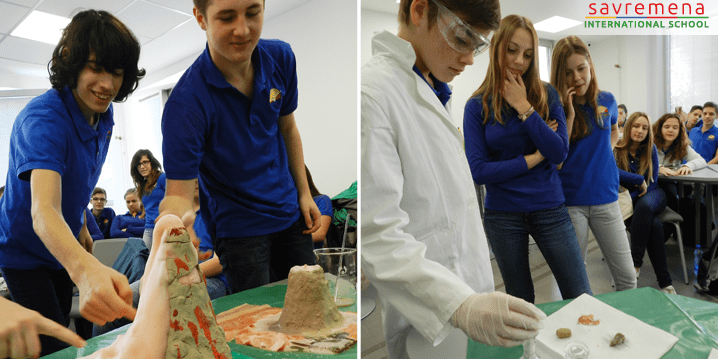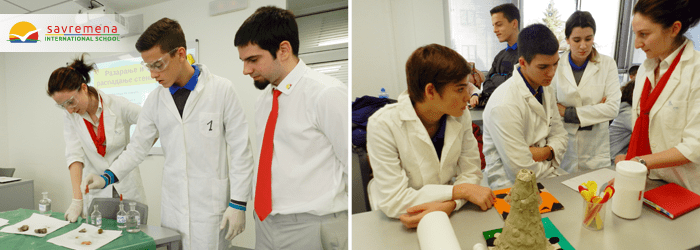Have you ever heard of “geo-chemistry”?
In Savremena, our students don’t find this science unfamiliar, because interdisciplinary lessons are rather frequent here. Connecting information from various subjects is utterly important for acquiring functional knowledge, and that is why one lesson combined geography and chemistry.
By conducting experiments our students learnt about the destruction and decomposition of rocks and also about volcanic eruptions.
Preparation in art
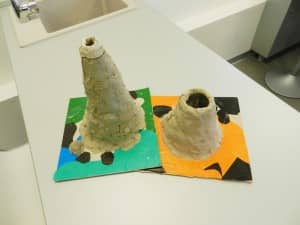 This event was introduced by an art club activity where students made volcanoes critical for their lesson in geo-chemistry. In order to make this relief forms, they used modelling clay and tried to make the result the most credible.
This event was introduced by an art club activity where students made volcanoes critical for their lesson in geo-chemistry. In order to make this relief forms, they used modelling clay and tried to make the result the most credible.
These prepared volcanoes were only part of the designed repertoire. For the needs of the experiments, our geography teacher Ivan Matejic, brought several rocks of different composition, whereas our chemistry teacher Bojana Jurisic, prepared solutions of two acids – hydrochloric and sulphur.
Acid rains are one of the major issues mankind faces, as well as the presence of halogens in the atmosphere. This way we wanted to manifest to our students how acids present in nature influences the destruction of rocks and how they can contribute to the environmental protection.
Geographical beginning
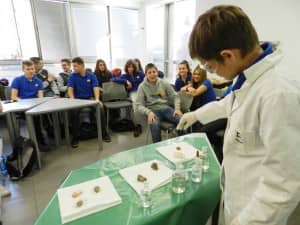 This double lesson was held with the goal of explaining chemical and physical processes that form the relief of Earth to our students more closely and practically.
This double lesson was held with the goal of explaining chemical and physical processes that form the relief of Earth to our students more closely and practically.
Geography teacher opened his lesson with a presentation of common processes which happen under the influence of external forces (e.g. sun, wind and water).
This practical work on the rocks manifested physical and biogenic destruction of rocks.
Live experiments
After gaining knowledge of the topic from the point of view of geography, the time came for our students to get acquainted with the same matter but this time taking the chemistry angle as the starting point.
Dressed in chemistry coats and wearing protective goggles like true little researchers and scientists, the students treated different types of rocks with acid.
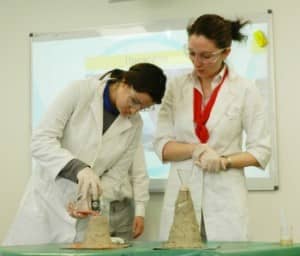 They used two types of acid, the sulfur and the hydrogen chloride, both of which are strong and extremely reactive but which permitted students to witness the same chemical process as the one that takes place in the Nature.
They used two types of acid, the sulfur and the hydrogen chloride, both of which are strong and extremely reactive but which permitted students to witness the same chemical process as the one that takes place in the Nature.
The students particularly appreciated the fact that they alone tested the presence of carbonates, i.e. of carbonate salts in rocks. When mixing carbonate salts and acid what happens is a dissolution of the carbonate ion in carbon dioxide.
Carbon dioxide is a gas which is released by the rocks and appears in the form of ‘little balloons’ or ‘bubbles’. When treating a rock with acid and these bubbles appear, we can claim that the presence of carbonates is undisputed.
These experiments showed students how, for instance, the amount of acid in an acid rain affects the dissolution degree of the rocks. At the same time, the students applied this knowledge to analyse the influence of these chemical processes on statues, buildings or monuments in their city, thus placing what they learned in a contemporary context.
Eruptions for the end
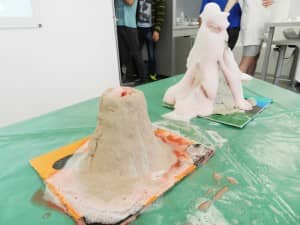 The finale of this lesson was remembering volcanism and processes that go on inside volcanoes. The previously prepared volcanoes were now put forward. The students caused exciting volcanic eruptions with the help of two different chemical processes.
The finale of this lesson was remembering volcanism and processes that go on inside volcanoes. The previously prepared volcanoes were now put forward. The students caused exciting volcanic eruptions with the help of two different chemical processes.
For the first volcano they used the chemical reaction between acetic acid and soda, thus releasing carbon-dioxide in the form of a gas, making bubbles. Considering the amount of those bubbles and water, this reaction was rather stormy, and so the great number of “coloured” bubbles rushed out of the volcano and caused the eruption.
For the second volcano they used the reaction of decomposing hydrogen peroxide (also known as hydrogen). For decomposing this substance they used yeast. These “yeast” cells “lent” their enzymes (biocatalysts) for decomposing hydrogen peroxide and released water and oxygen. Considering the fact that this reaction releases energy, this reaction was hot and steaming, just like a real volcano.
Lava flowed through the chemistry lab at the end of yet another interdisciplinary lesson in Savremena.
More pictures in gallery.



